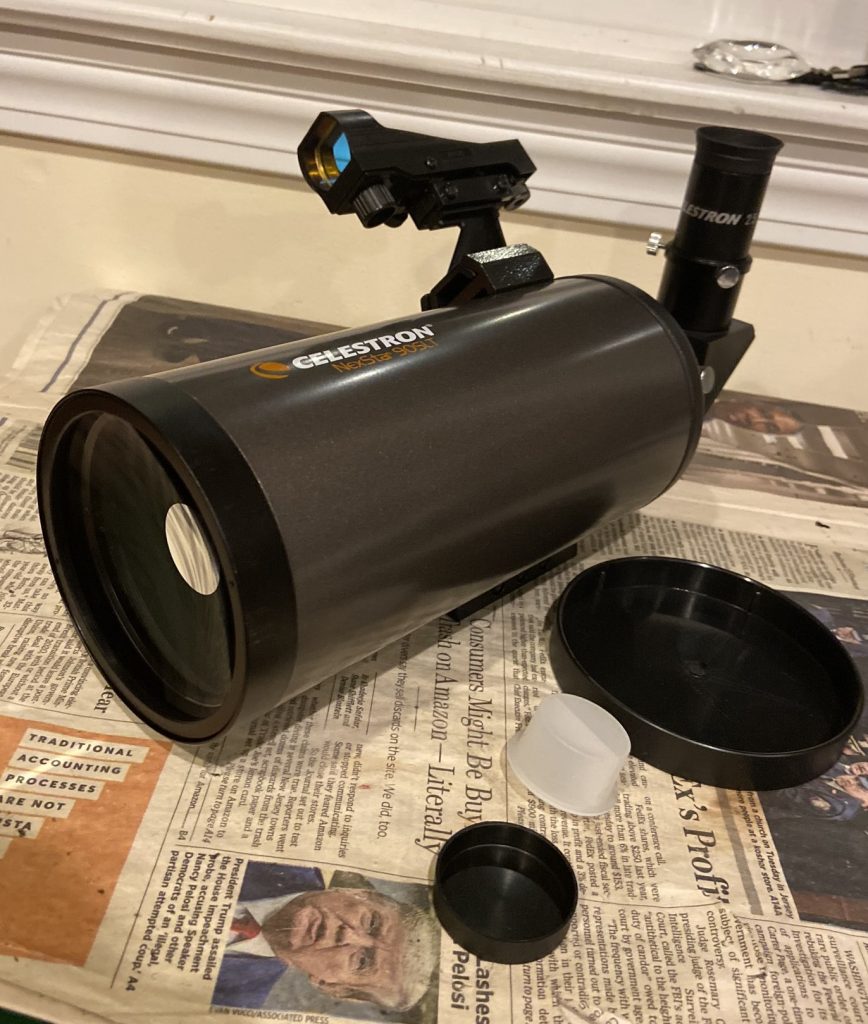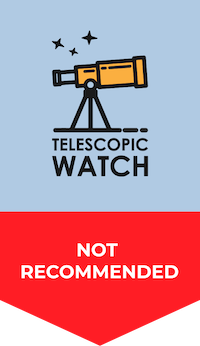The Optical Tube
The NexStar 90SLT is a 90mm f/13.3 Maksutov-Cassegrain with a focal length of 1250mm; a variety of other telescopes use the exact same optics as the 90SLT with no appreciable differences. Being a Maksutov, there’s little to no need to collimate the telescope, and the mechanisms to do so are not really provided in any case. The optics in the 90SLT are superb in quality, but you are severely limited in light-gathering power and resolution with a telescope this small,

Focusing the 90SLT is accomplished by turning a knob at the back of the scope, which moves the primary mirror back and forth on a rod. Thanks to its minuscule size and weight, the image does not “shift” during focusing as it can with some catadioptric instruments. The scope uses a proprietary threaded adapter as a 1.25” visual back to hold the diagonal-don’t lose this adapter and don’t unscrew it, as replacing it is difficult. You cannot use a 2” diagonal or focal reducer on the 90SLT as it will vignette severely.
The 90SLT attaches to its mount with a short Vixen-style dovetail rail, making it compatible with a variety of other mounts and tripods. It can also be attached to most heavy-duty photo tripods with the threaded ¼ 20 holes in the dovetail bar.
Accessories
The NexStar 90SLT Mak comes with two 1.25” barrel eyepieces: a 25mm Kellner unit providing 50x for “low” magnification, and a 10mm Kellner ocular providing 125x for higher power. Both are all-metal in construction and fairly good quality, with apparent fields of view of 50 degrees. Thus, the 25mm provides about 1 degree of a true field (2 full moons) and the 10mm about 0.4 degrees (a bit smaller than the moon). Normally we’d say that a pair of two included Kellner eyepieces is inadequate for a telescope, but in the case of the 90SLT, there really isn’t much of a purpose in buying anything else. A lower-power eyepiece would actually vignette somewhat due to the 90SLT’s small baffle tube, and you can’t really push the scope past 150x, which isn’t appreciably different from 125x.
The 90SLT also comes with a 1.25” prism star diagonal, which you basically need to use the telescope. It’s quite high quality and works well.
For a finder, Celestron’s standard “StarPointer” red dot is included; a red dot finder is more than adequate for such a small instrument, and you are really only supposed to use it to align the GoTo mount anyway, after which the 90SLT’s electronics take over the task of aiming the telescope at targets.
Mount
The NexStar SLT mount is essentially just an updated NexStar GT mount, which has been around since the early 2000s. The same mount and tripod hardware is also used in the SkyProdigy and Astro-Fi mounts.
One of the most common complaints about the SLT mount is that it is not stable. This is a problem with pretty much all of the larger telescopes in the SLT line, but the 90SLT optical tube is short and weighs next to nothing. The SLT mount supports it with ease, despite its mechanical shortcomings. The mount is a GoTo design and cannot be moved manually at all; you have to power it up in order to use it. This means that even though it’s quite easy to carry the entire telescope in one hand, setting it up by levelling the tripod, turning the mount on, and aligning it with a few bright stars will take a minimum of five to ten minutes of effort, and as such, the convenience factor that should exist in a small, low-maintenance, and compact instrument is greatly diminished. The mount doesn’t even have an internal clock, so you have to set the date and time every time you turn it on as well.
The database in the NexStar SLT mount’s hand controller contains about 4,000 objects. You can’t see many of these with the 90SLT due to its small aperture, especially under suboptimal conditions. You are limited to the brightest galaxies, star clusters, nebulae, and, of course, the Moon and planets. The main utility of the SLT mount with this scope is arguably the motorised tracking, which is pretty accurate, if a bit jerky at times and quite loud.
For those who do not enjoy the hand controller, Celestron sells a Wi-Fi adapter for the SLT mount so you can run it off your phone, but you could also just buy the Astro-Fi 102 model Celestron sells, which has more aperture, largely the same features, and runs off a phone or tablet by default.
For power, the NexStar SLT mount requires 8 AA batteries, which will last a few hours at most. This is inconvenient and can become expensive rapidly. As such, a portable DC power supply is probably a good idea, but you should always leave the batteries in just in case-a loose connection will turn the mount off and require restarting and re-aligning, which can get infuriating.
Should I buy a Used NexStar 90SLT?
A used 90SLT is still a 90SLT, and its usefulness is limited. But at the right price and assuming the telescope has been reasonably well taken care of, there’s not too much to worry about if the mount powers on and the optics of the telescope are in good shape.
Alternative Recommendations
The NexStar 90SLT is one of the least cost-effective telescopes in its price range. While our recommendation would probably be to steer you towards choosing a manual Dobsonian telescope, there are also a variety of superior computerized instruments available as well.
- The Sky-Watcher Heritage 150P has almost double the aperture of the 90SLT, can be set up in seconds, and is even more portable, with a wider field of view to boot.
- The Celestron Astro-Fi 102 has a larger aperture and an easier to use mount than the 90SLT.
- The Sky-Watcher Virtuoso 90 has the same optics and accessories as the 90SLT, but with a faster to set up tracking mount and a solar filter included too.
Aftermarket Accessory Recommendations
A dew shield is a must for the NexStar 90SLT, as with any catadioptric telescope, to slow down frost or dew formation on the 90SLT’s front corrector plate, as well as to minimise glare from nearby light sources entering the telescope, and also to safeguard against pollen, dirt, and dust. It might also be beneficial to acquire a few additional eyepieces to enhance your collection. A 32mm Plossl eyepiece for 39x magnification with the NexStar 90SLT offers a marginally wider field of view and reduced magnification compared to the supplied 25mm eyepiece, making it more suitable for observing deep-sky objects, though you are still of course limited by the diminutive aperture of this planetary-oriented telescope.
Although the supplied 10mm eyepiece offers ample magnification for this relatively compact scope, a 9mm redline/goldline (139x magnification) is somewhat sharper and more comfortable to use than the 10mm 3-element eyepiece if you’re willing to invest the money. You might also consider adding a 15mm redline or goldline wide-angle eyepiece (83x magnification) for medium power.
A rechargeable power supply is essential for a computerised telescope like the NexStar 90SLT to avoid dealing with disposable batteries or extension cords. We recommend a TalentCell 12V power pack or equivalent for the 90SLT.
What can you see with NexStar 90SLT?
A 90mm Maksutov is widely regarded as primarily a quick-look or “grab n’ go” instrument, capable of giving sharp views of solar system objects but not much else.
Mercury’s small angular size and proximity to the Sun mean it’s downright impossible to see any detail on it with any telescope, and its lack of visibility can also make it difficult to locate. The 90SLT’s GoTo mount somewhat helps in this regard, though getting it ready before Mercury sinks below the horizon may be difficult. The 90SLT will be able to show you its phase. Venus is much easier to see and much bigger, but its surface is completely obscured by dazzlingly reflective cloud cover.
The Moon looks fantastic in the 90SLT’s eyepiece, with craters, ridges, and mountains only a few miles wide easily visible-the views are best around first quarter, when the Moon is high in the sky but not blindingly bright or lacking in shadows. Mars similarly requires good timing; the planet is only close enough to Earth to show detail for a few months out of every 2-year period. When Mars is close to opposition, you can see a few dark markings on its surface and an ice cap with the NexStar 90SLT, albeit not much else.
Jupiter looks fantastic with the NexStar 90SLT; it’s four largest moons are easily visible moving around the planet, and Jupiter itself shows a number of colourful cloud bands. The Great Red Spot can be difficult to perceive at times, however, and the 90SLT lacks the resolving power to clearly and consistently show the moons as actual disks or their shadows when they transit across Jupiter itself.
Saturn’s rings and the Cassini Division within them are easily spotted with the NexStar 90SLT, and its cloud bands can also be faintly seen. Titan is fairly obvious, but the fainter moons are harder to spot on account of their low brightness.
Uranus and Neptune appear as merely bluish dim, star-like points as seen in the NexStar 90SLT, with the telescope’s small aperture insufficient to clearly resolve the disk of either planet nor grasp the dim glow of their moons. Identifying Neptune in particular as being distinct from nearby stars may even present a challenge.
The NexStar 90SLT will have a hard time showing anything at all of the deep-sky objects from a light-polluted location. Its narrow field of view does not help. Open star clusters barely fit in the field of view in some cases, and similarly, the 90SLT is too “zoomed in” to take in bright and eye-popping views of emission nebulae like Orion or the Lagoon. Globular clusters may reveal a few of their outer members under perfect viewing conditions, but by and large they remain to appear as simply unresolved fuzzy blobs. Planetary nebulae like the Ring and Dumbbell can be seen, but they are dim and lack detail.
Galaxies are perhaps the most disappointing thing of all; even under dark skies, the 90SLT can show you only the brightest galaxies with little to no detail, and under light-polluted conditions, anything beyond Andromeda and M82 is invisible.
The 90SLT’s biggest strength on objects outside the Solar System is arguably double stars. You’ll be able to resolve many of them into perfect, colourful, tiny disks just barely touching each other at high magnification under steady skies. The scope’s plentiful database can also easily find many of them, and of course, even under light-polluted skies, you’ll have no trouble splitting doubles.
Astrophotography Capabilities
The NexStar 90SLT is completely incapable of deep-sky astrophotography on account of its super-long focal ratio and completely insufficient mount. However, it can be used for some lunar and planetary astrophotography with a high-speed astronomical video camera and a Barlow lens. You simply take a short video, stack it in a programme like RegiStax or AutoStakkert, and conduct final processing.


